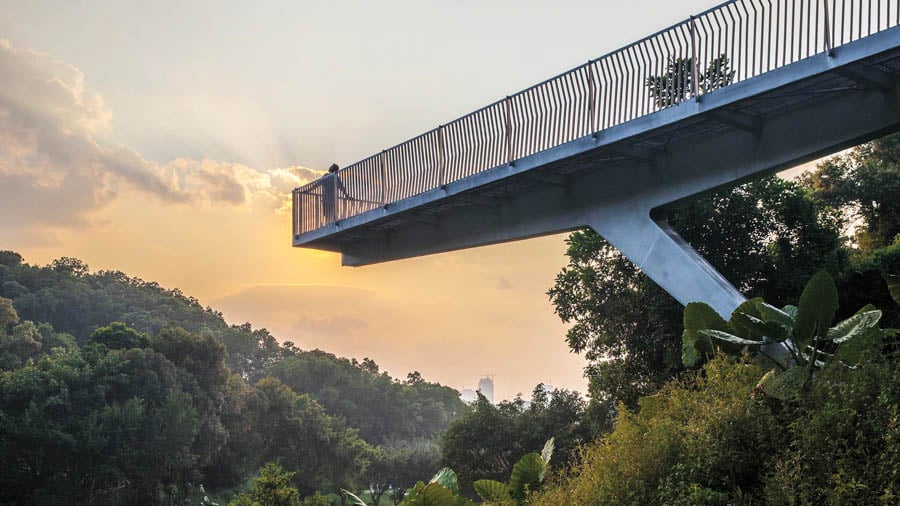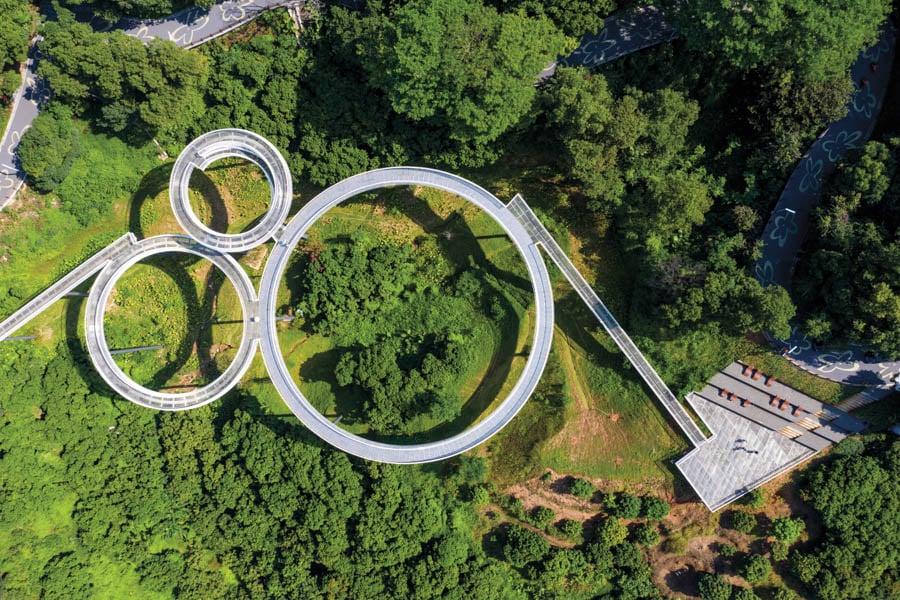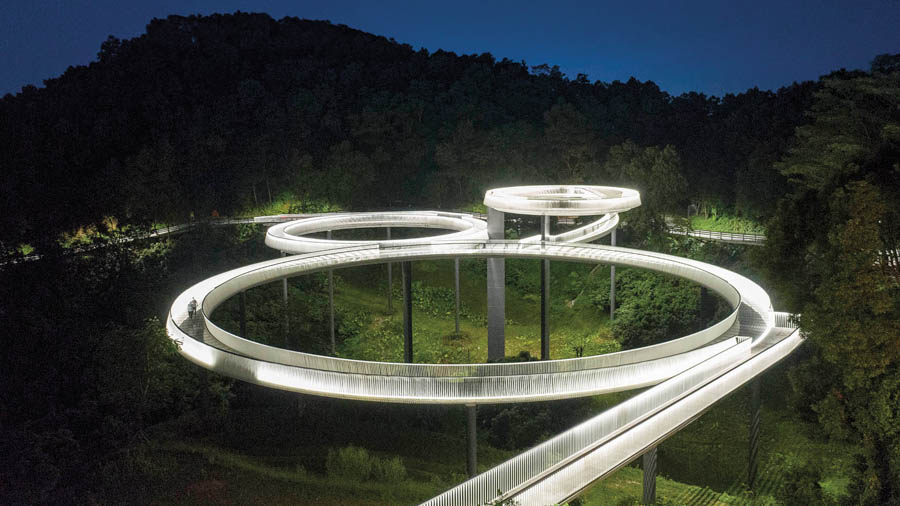
November 4, 2020
Floating Bridges Make Up SWA Group’s Design for a Mountain Park
A greenway project outside Shenzhen reflects complementary considerations of nature, health, and technology.

On the outskirts of Shenzhen, China, landscape architecture firm SWA Group has recently led the design of a greenway that comprises several bridges. Located off the park’s main trail is Floating Bridge—so named because it is suspended 125 feet above the forest floor—which takes the form of three intersecting rings offering views and diversions.
In 2016 Chinese president Xi Jinping announced Healthy China 2030, a landmark policy blueprint designed to advance public health in China. It set benchmarks for improvements in everything from the percentage of citizens who regularly exercise to average life expectancy. (Mainland China currently is ranked 104th on the CIA’s list of countries’ average life expectancies with 75.7; the United States, at 80, is ranked 45th.)
The policy has since catalyzed enormous investments in health care and medicine, but also in green space and nature. “In an earlier time, we were very focused on ‘boom, developing, developing, developing.’ Now people focus more on ecological issues,” says Shuyi Chang, a principal in the Shanghai office of international design firm SWA Group.
Chang recently led the design of the Guangming Dadingling Mountain Forest Greenway, a 15-mile-long pedestrian and bike path located 40 minutes from downtown Shenzhen (or ten minutes via high-speed train). Here, the hyperactivity of the city dissolves into a hushed landscape of eucalyptus and lychee forest and sprawling agricultural fields. An existing red-brick path wove through a portion of the site but was narrow and lined with a chain-link fence. In 2017, SWA Group was hired to improve the trail—partially to meet requirements for future mountain marathons—and develop a long-term master plan for areas surrounding the greenway.

Completed later that same year, the master plan identified the eastern, more mountainous portion of the site, where the existing path was located, as an area of ecological sensitivity that should be preserved and, if possible, restored to native conditions. (The lychee and eucalyptus trees are remnants of historical plantations and outdated reforestation efforts.) To augment the trail experience and attract a more diverse group of users, SWA also proposed a series of spectacular bridges, which branch off from the main path to create overlooks and gathering places.
The bridges offer sweeping—and occasionally heart-stopping—vistas but were also designed as sculptural objects in and of themselves. Floating Bridge, located at the northern end of the trail, consists of a trio of intersecting stainless-steel rings ranging from 65 to 165 feet in diameter and raised 125 feet above the forest floor on charcoal-black steel columns. Wrapped in angled railings and illuminated with clean white LEDs, the structure becomes a mesmerizing, otherworldly object within the forest landscape, a beacon that draws visitors off the main path and into the sky.
Discovery Bridge, located several miles to the south, is an elliptical gathering space punctuated by a cantilevered lookout. Tucked away from the main path, it rewards exploration and provides a more intimate connection with native wildlife. The third bridge, set to open this fall, is perhaps the most jaw-dropping. Strung between the main trail and a previously inaccessible ridge, Hanging Bridge is the first stress-ribbon pedestrian bridge in China, using a single canted column and a “ribbon” of steel to support its 200-foot span.

The design team worked hard to thread the needle between environmental sensitivity and architectural spectacle. The client, a state-owned development entity known as Overseas Chinese Town Enterprises Co., initially handed SWA a list of somewhat paradoxical criteria, Chang says. Each bridge was to display a high degree of artistic creativity, technological innovation, and sensitivity to the ecology of the site. “Can you imagine a trail that is ecological and high-tech?” she asks, laughing.
Specifically, the client pointed to an LED track built by Nike in Manila that uses sensors to track a runner’s performance and then displays an avatar on a vertical LED screen, essentially allowing runners to race themselves. Lit with flashing pink and yellow lights, the atmosphere of the figure-eight-shaped track is brash and clublike, which might befit a corporate spectacle in an urban context but was wrong for a mountain trail in Guangming, Chang says. “We argued and debated for a long time. [We said], ‘That’s not the right way. If you want to bring back habitat, how can you have this LED show?’”
Instead, SWA allowed environmental factors to dictate the deployment of the bridges’ various technologies. The lights that illuminate Floating Bridge are powered by glass-covered solar pavers integrated into the decking of the largest of its three rings, and Hanging Bridge is designed to sway in response to the strong winds that are funneled through the valley. (Initially named Wind Song Bridge, the structure is meant to include a giant wind chime dangling from its steel straps.)
The first section of the new trail, including the first two bridges, opened in January 2020. It became an instant destination, Chang says. “We had a soft opening before Chinese New Year, before the pandemic, and we looked at Weibo and TikTok, and it’s all over the place. This is the number one hot spot in Shenzhen.” But Chang hopes the greenway provides an opportunity for more than selfies. She wants visitors to forge a deeper connection to nature and recognize the health benefits that it offers. “We don’t want to do something fancy,” she says. “We want to encourage the younger generation to come and experience nature.”
You may also enjoy “Black Landscapes Matter: Q&A with Landscape Designer Walter Hood.”
Would you like to comment on this article? Send your thoughts to: [email protected]
Register here for Metropolis’s Think Tank Thursdays
and hear what leading firms across North America are thinking and working on today










